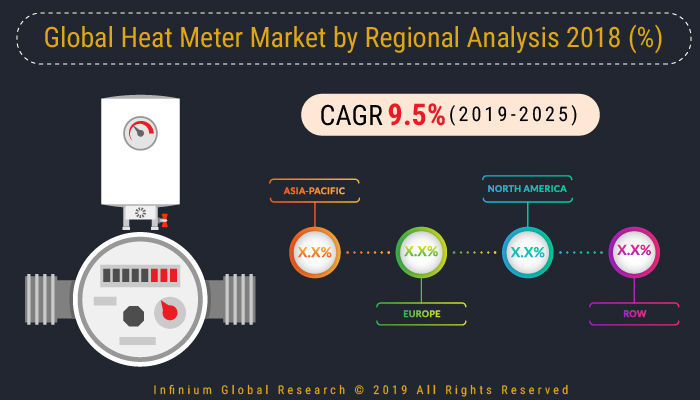A recent report published by Infinium Global Research on the heat meter market provides an in-depth analysis of segments and sub-segments in the global as well as regional heat meter market. The study also highlights the impact of drivers, restraints, and macro indicators on the global and regional heat meter market over the short term as well as long term. The report is a comprehensive presentation of trends, forecast and dollar values of the global heat meter market. According to the report, the global heat meter market is projected to grow at a CAGR of 9.5% over the forecast period of 2019-2025.
Market Insight
With the rising cost of energy and an emphasis on energy reduction, accurate and reliable metering of all utilities has become essential for measuring and managing energy costs. Heat meters determine the heat energy transported by measuring fluid flow rate and the change in its temperature between the outflow and return flow of the system. Heat meters provide the metering of heating and cooling energy in hydronic systems based on volume, and supply and return temperatures. It is normally used in industrial applications for measuring boiler output from a heater and the cooling output from a chiller unit. It is also used for district heating systems to measure the heat delivered to consumers.
Effective measurement of heat consumption is the major growth factor of the heat meter market. The factors such as the increasing number of digitalization of power utilities, growing adoption of district heating systems, increasing demand for accurate and reliable heat metering system, and rapid development of commercial as well as residential formations are driving the growth of the market. The demand for heat meters is increasing due to its features such as high durability, low energy consumption, data accuracy, and long-term stability. The increasing investments toward the expansion of the service sector across the world are fueling the growth of the market. However, the high capital costs of heat meters are restraining market growth. Moreover, the increase in the district heating infrastructure is expected to provide growth opportunities to the market players in the forecasted period.
Geographically, Asia-Pacific dominates the heat meter market due to the rise in construction activities and changes in climatic conditions. Rising demand for effective energy management systems along with the growing need for individualized metering across residential buildings is expected to boost the heat meters market growth in this region. Ongoing regulatory mandates toward the development of policies for energy metering along with increasing focus toward energy efficiency and cost saving will accelerate the growth of the market in the North America region.
Segment Covered
The report on the global heat meter market covers segments such as type, connectivity, and end-user. On the basis of type, the sub-markets include mechanical, and static. On the basis of connectivity, the sub-markets include wired connection, and wireless connection. On the basis of end-user, the sub-markets include residential, commercial, and industrial.
Companies Profiled:
The report provides profiles of the companies in the market such as Kamstrup, Diehl Stiftung & Co. KG, The Danfoss Group, Landis+Gyr, Siemens AG, Techem GmbH, Itron, Qundis, Ista, Zenner International GmbH & Co. KG, and other companies.
Report Highlights:
The report provides deep insights into the demand forecasts, market trends, and micro and macro indicators. In addition, this report provides insights into the factors that are driving and restraining the growth in this market. Moreover, The IGR-Growth Matrix analysis given in the report brings an insight into the investment areas that existing or new market players can consider. The report provides insights into the market using analytical tools such as Porter's five forces analysis and DRO analysis of the heat meter market. Moreover, the study highlights current market trends and provides forecast from 2019-2025. We also have highlighted future trends in the market that will affect the demand during the forecast period. Moreover, the competitive analysis given in each regional market brings an insight into the market share of the leading players.

